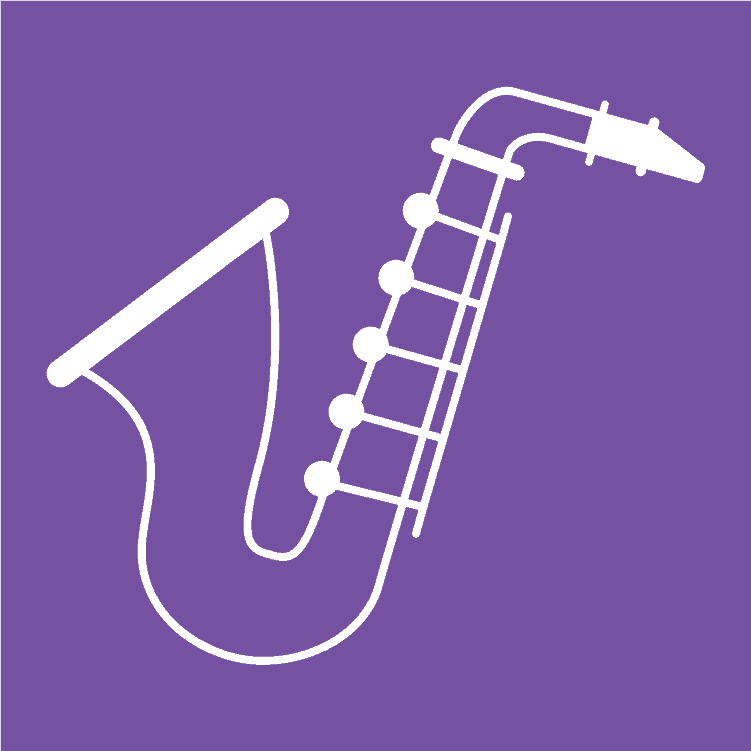Saxophone Learning Methods
The best way to learn the Saxophone
As a part of our ‘Beginner’s Guide To Learning The Saxophone’ collection, this unique section offers you the knowhow to figure out which approach to learning will most likely be most effective for you as well as your individual situation.

What Choices Are Best For Mastering The Saxophone
All people learn in different ways. Lots of people can remember telephone numbers immediately, whilst other people might not even have the capacity to read. We’re all special and unique. It’s due to this that I can confidently declare that there isn’t one ideal approach to studying a musical instrument.
The four key learning techniques that exist are:
- Traditional, face-to-face, one-to-one learning
- Traditional, face-to-face, group lessons
- Video Tutorials
- Apps
Whatever your very own circumstance, one of these four options will likely be appropriate for you. We only need to find out which one…

Traditional, face-to-face, one-to-one sessions
If you think of Saxophone lessons, the initial image is most likely something like this…
Getting exclusive, one-to-one sessions is definitely an incredible experience if you discover the appropriate instructor. There really is no replacement for taking in all the knowledge of your teacher.
Our Founder, Robert Emery, ended up being coached by Ruth Nye at the Royal College of Music. She really was among the finest instructors across the world, and the fact that Robert could soak up her knowledge in four years ended up being a priceless gift.
There exists an issue though:
Not every trainer offers the experience of Ruth Nye.
In truth, the alarming matter is the fact that to be a music trainer, you actually don’t require any qualifications whatsoever. Nothing. Zip. As a complete amateur, you could be taking money from people and pass yourself off as being a pro. And this, beloved visitor, is the most important disadvantage to a traditional mentor:
Quality control.
It is advisable to look for a really knowledgeable coach that you connect with. Who realizes both you and your demands. Who makes you giggle. Whom you look forward to going to see weekly. If you can find this person, you will have then attained something most people fail at. Becoming empowered because of your teacher is the magic dust which will keep you learning for many years.
Out of all the options on this page, this is actually the costliest. But as usual with things in life, you are likely to get what you pay for…

PROS
- Personalised feedback
- Lessons Adapted To Your Style Of Learning
- The Most Efficient Way Of Learning
- Can Be The Most Inspiring Option
CONS
- Expensive
- Difficult Scheduling
- Finding Right Teacher Is Difficult
- Requires You To Travel
Conventional, face-to-face, Class sessions

Based upon your geographical area, you might be able to find group sessions. The ethos is just like one-to-one training, though the price is reduced since the trainer has to split their time between every one of the students.
For orchestral musical instruments, like violins, group lessons are quite a smart idea, to begin with. Virtually all professional violinists in fact end up as one of many violins inside an orchestra. Saxophone will be slightly different, however. It is very much a solo instrument.
How often have you seen saxophone players playing together in a group? Thought not…
PROS
- Personalised feedback
- Can Be Fun Learning In A Group
- Cheaper Than One-2-One Lessons
CONS
- Difficult Scheduling
- Limited Choice Of Teacher
- You'll Learn At The Speed Of The Group
- Sharing The Teacher With Others
- Requires You To Travel
Video Tutorials
Free Courses

YouTube is definitely the largest source of video lessons on the planet. There is absolutely no greater place than YouTube to discover instructional information for saxophone. Because of the sheer amount of choices on the platform, it’s impossible to review them all.
Similar to most mass appeal platforms, 95% of the content is total garbage, with the other 5% totally free gold dust. Finding that 5%, however, is definitely tricky!
We can give you a head-start though. We quite like Rico’s YouTube Channel (which features video lessons by well-known saxophonists Michael Brecker and Kenny G, amongst others), and Taming the Saxophone (this is a wonderful resource offering a vast array of material, both written and practical. Much of the content is free to access, but an £11-16.95 payment will unlock even more material).
One word of warning: If you want to learn ‘classical’ saxophone or are interested in taking practice exams, we would strongly recommend having real-life human teaching you, in the same room! The reason? Learning to play the saxophone in this way is far more complicated than playing pop songs. However, if you’re pop-tastic, then YouTube is a great option.
If you don’t wish to spend money, and therefore are happy to spend time while seeking for top quality content that inspires you, then there is no better place.
Paid Courses

With thousands of paid training on the internet, it’s totally unattainable to evaluate every one of them. Therefore we thought we would simply provide the two most popular choices:
At the time of writing, Udemy is by far the largest online source for paid courses aimed at teaching the individual how to learn to play the saxophone and further develop your skillset. With the average price of courses around £12, it’s fairly cost-effective to try a few and find the one for you. There are a selection of courses pitched at beginners-advanced, exploring funk, jazz, youTube and stage performing, and how to play iconic sax solos. Udemy offers a creative, fun approach to learning to play the sax, though a word of warning in the spirit of honesty, their claims to take you from beginner to pro in under four hours are very bold! That said, you’ll likely have a solid level of proficiency at the end of any Udemy course to really enjoy playing some of your favourite songs.

Based in the UK, the McGill Music Sax School offers over 600 lessons, through more than 60 courses, for all levels of player. Rather than purchasing specific courses, McGill runs on a monthly or yearly membership subscription approach, costing £25 for the former, or £200 for the latter. A yearly membership will unlock extra bonus courses not accessible on the monthly scheme. It is worth noting that McGill Sax School is more interactive than many, with a monthly live, group masterclass included in price, which not only provides a public performance opportunity on which you will receive feedback, but also ensures regular Q&A opportunities with big boss, Nigel McGill. Should you wish even more personal contact, individual lessons can also be arranged, in addition to the standard membership content
PROS
- Low Cost or Free
- Huge Amount of Content
- Learn Whenever You Want
- No Travelling To Lessons
- Great For Popular Material
CONS
- So Much Choice It's Difficult To Find Great Content
- Quality of Content Is Questionable
- Not Great For Classical Playing
About the Author
Robert Emery
Robert Emery is Founder & CEO of Ted's List. He has performed all around the world as a conductor and pianist. From Sydney Opera House to the Royal Albert Hall, Robert has enjoyed bouncing around on stage in most of the major venues in the world. As a record producer, he has worked on fifteen No 1 albums, and hopes he can get to sixteen asap!
The Times called him 'the eccentric barefooted maestro' and the Mail quoted that 'the assured baton was controlled by the rather energetic and brilliant conductor'.
Robert has a wife (Mrs. E), two children (Master T and Master A) and four cats (Merlin, Mulberry, Partridge & Penguin). Between performing, producing, composing and running Ted's List, he runs an entertainment business called The Arts Group, comprising of a symphony orchestra, choir, live event production house, digital TV company and artist agency. Any spare time is usually devoted to sleep.
Other posts by this author
Zoom Lessons

If you’re looking for that one-to-one setup, but don’t want to trek around to a teachers house every week, then online lessons can work really well.
There are A LOT of companies out there that do lessons over Zoom, so you have to be ultra careful the quality is up to scratch. But the service we have found that has consistently great feedback is www.lessonwithyou.com. We like that they offer a half-hour lesson completely for free so you can try out the service and that they offer flexible scheduling with no contracts. They have teachers from Julliard, Berkeley, and Johns Hopkins – so the standard is high. Lastly, we LOVE that they don’t as for your credit card details for the trial lesson.

Saxophone Apps

We understand best when the teaching is tailored to our particular requirements. Apps are really a hybrid between conventional training videos and an actual life coach. They alter their training based upon your response to the application. For this reason, if you aren’t able to have face to face sessions, we would always encourage specialized apps over general YouTube video lessons. There are many, many apps out there. The ones we advise are:
PLAYALONG ALTO SAX
PlayAlong Alto Sax is a multi-platform learning app that is advertised as appropriate for players of all levels. The USP of this app is that you learn to play songs chosen from the large and varied music repository available (and here is the fun part!), playing from the score, into the app (via the microphone built into your mobile). The app then responds with a guided version of the chosen tune, playing back your recording and displaying a moving marker to show the current note, highlighting write/wrong notes in different colours, allowing you to evaluate your performance with a critical ear. You may customise the display, choosing whether you would like to add fingering charts and note names onto the score.
Not only this, but the app brings in an element of self-competition, as it keeps track of your accuracy, providing (objective) performance-related stats in the form of score points. Recordings made via the app can be shared via email with friends/family/teachers.
This app is a lot of fun, particularly for beginners and we feel in particular, those in the younger age bracket especially. The ability to listen back to your own recordings with corrections clearly labelled is especially helpful. Additionally, the app includes 16 scales for the student to work through (for £1.99). A small portion of the content on the app is free of charge, but a mere £4.99 for the ‘Mega Pack’ deal will unleash access to over 110 songs, or alternatively, it averages at 99p per track if songs are purchased individually.
The downside? The interface is somewhat basic, and we would suggest that despite advertising content for all performing abilities, it is most effective for beginner-intermediate saxophonists.

TONESTRO
Tonestro is an educational app made by and aimed at wind players. Much like the PlayAlong Sax app, this is a tool for recording, analysing and improving your music reading abilities.
This app looks good! The interface is very user-friendly and uses more impressive graphics. Whereas PlayAlong Sax feels like it would be most engaging for beginners, Tonestro would also suit adult players. There are numerous ‘challenges’ available which connect you with other app users, and there is a ‘campaign’ element, which essentially guides you up, through the different Tonestro levels.
The app is free-£40.99 yearly, a cost which unleashes unlimited access to more than 1000 songs. We think this is well worth the cost and ranks no.1 in our list…
PROS
- Best Cost Effective/Quality Ratio
- Can React To Your Level Of Learning
- Great For Popular Material
- No Travelling To Lessons
CONS
- No Personal Feedback On Your Playing
- Not Great For Classical Playing
Saxophone Learning Methods - Summary
Let’s keep things easy…
If you want to play popular (pop/rock etc) music in particular, or work through a large catalogue of short melodies, then the best ratio to being cost-effective, but higher quality content, is an App. Specifically, we like Tonestro.
If you want to play jazz or classical music, or work through music exams, have a fantastic technique, and learn to read music, then getting a face-to-face, one-to-one teacher is by far the best option. And more than likely, the most inspiring option if you decide that your saxophone journey is one that may well last into the future (and not just be a flash in the pan!).
Hopefully, that helps you make up your mind about what method of learning is going to be best for you. Now you’ll need to do some research over which exact option to go for. Lucky for you, we do just that!
Get Access To An Array Of Amusing Musical Things
4-Feature Friday does what it says on the tin; sends you an email every Friday with four of the most amazing things I’ve found that week
It might contain unique freebies or possibilities to interact with me personally, musical instruments, books, products, music and songs, brand-new techniques/tips, and — of course — a number of pleasurable musical things I dig up from around the globe.
Be a part of our online community and enjoy the 4-Feature Friday email by subscribing below
Read the next post in this series:






